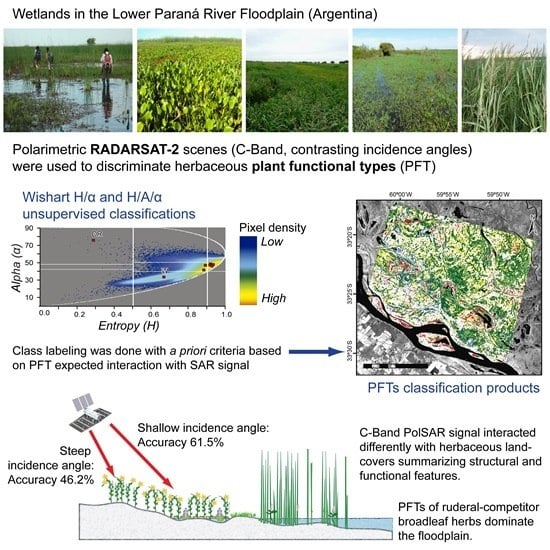Mapping Plant Functional Types in Floodplain Wetlands: An Analysis of C-Band Polarimetric SAR Data from RADARSAT-2
Abstract
:1. Introduction
2. Materials and Methods
2.1. Study Area
2.2. SAR Data Acquisition and Processing
2.3. Classification of Areas Dominated by Plant Functional Types
2.3.1. Information Classes: Sampling and Characterization
2.3.2. H/A/α Segmentation
2.3.3. Wishart Unsupervised Classifications on the Coherence Matrix
2.3.4. Accuracy Assessment
3. Results and Discussion
3.1. Description of the Scenes and Field Samples
3.2. H/α Segmentations
3.3. Unsupervised Wishart H/α and H/A/α Classifications
3.4. Comparison between Incidence Angles and Accuracy Assessment
4. Conclusions
Supplementary Materials
Acknowledgments
Author Contributions
Conflicts of Interest
References
- Junk, W.J. Current state of knowledge regarding South America wetlands and their future under global climate change. Aquat. Sci. 2012, 75, 113–131. [Google Scholar] [CrossRef]
- Baigún, C.R.M.M.; Puig, A.; Minotti, P.G.; Kandus, P.; Quintana, R.D.; Vicari, R.L.; Bó, R.F.; Oldani, N.O.; Nestler, J.A. Resource use in the Parana River Delta (Argentina): Moving away from an ecohydrological approach? Ecohydrol. Hydrobiol. 2008, 8, 245–262. [Google Scholar] [CrossRef]
- Junk, W.J.; An, S.; Finlayson, C.M.; Gopal, B.; Květ, J.; Mitchell, S.A.; Mitsch, W.J.; Robarts, R.D. Current state of knowledge regarding the world’s wetlands and their future under global climate change: A synthesis. Aquat. Sci. 2013, 75, 151–167. [Google Scholar] [CrossRef]
- Mertes, L.A.K.; Daniel, D.L.; Melack, J.M.; Nelson, B.; Martinelli, A.; Forsberg, B.R. Spatial patterns of hydrology, geomorphology, and vegetation on the floodplain of the Amazon River from a remote sensing perspective. Geomorphology 1995, 13, 215–232. [Google Scholar] [CrossRef]
- Novo, E.M.L.M.; Shimabukuro, Y.E. Identification and mapping of the Amazon habitats using a mixing model. Int. J. Remote Sens. 1997, 18, 663–670. [Google Scholar] [CrossRef]
- Salvia, M.M.; Karszenbaum, H.; Kandus, P.; Grings, F.M. Datos satelitales ópticos y de radar para el mapeo de ambientes en macrosistemas de humedal. Rev. Teledetec. 2009, 31, 35–51. [Google Scholar]
- Silva, T.S.F.; Costa, M.P.F.; Melack, J.M.; Novo, E.M.L.M. Remote sensing of aquatic vegetation: Theory and applications. Environ. Monit. Assess. 2008, 140, 131–145. [Google Scholar] [CrossRef] [PubMed]
- Hess, L.L.; Melack, J.M.; Novo, E.M.L.M.; Barbosa, C.C.F.; Gastil, M. Dual-season mapping of wetland inundation and vegetation for the central Amazon basin. Remote Sens. Environ. 2003, 87, 404–428. [Google Scholar] [CrossRef]
- Pope, K.O.; Rey-Benayas, J.M.; Paris, J.F. Radar remote sensing of forest and wetland ecosystems in the Central American tropics. Remote Sens. Environ. 1994, 48, 205–219. [Google Scholar] [CrossRef]
- Silva, T.S.F.; Costa, M.P.F.; Melack, J.M. Spatial and temporal variability of macrophyte cover and productivity in the eastern Amazon floodplain: a remote sensing approach. Remote Sens. Environ. 2010, 114, 1998–2010. [Google Scholar] [CrossRef]
- Henderson, F.M.; Lewis, A.J. Radar detection of wetland ecosystems: A review. Int. J. Remote Sens. 2008, 29, 5809–5835. [Google Scholar] [CrossRef]
- Hess, L.L.; Melack, J.M.; Simonett, D. Radar detection of flooding beneath the forest canopy: A review. Int. J. Remote Sens. 1990, 11, 1313–1325. [Google Scholar] [CrossRef]
- Costa, M.P.F.; Niemann, O.; Novo, E.M.L.M.; Ahern, F. Biophysical properties and mapping of aquatic vegetation during the hydrological cycle of the Amazon floodplain using JERS-1 and Radarsat. Int. J. Remote Sens. 2002, 23, 1401–1426. [Google Scholar] [CrossRef]
- Novo, E.M.L.M.; Costa, M.P.F.; Mantovani, J.E.; Lima, I.B.T. Relationship between macrophyte stand variables and radar backscatter at L and C band, Tucuruí reservoir, Brazil. Int. J. Remote Sens. 2002, 23, 1241–1260. [Google Scholar] [CrossRef]
- Grings, F.M.; Ferrazzoli, P.; Karszenbaum, H.; Salvia, M.M.; Kandus, P.; Jacobo-Berlles, J.C.; Perna, P. Model investigation about the potential of C band SAR in herbaceous wetlands flood monitoring. Int. J. Remote Sens. 2008, 29, 5361–5372. [Google Scholar] [CrossRef]
- Kandus, P.; Karszenbaum, H.; Pultz, T.; Parmuchi, M.G.; Bava, J. Influence of flood conditions and vegetation status on the radar backscatter of wetland ecosystems. Can. J. Remote Sens. 2001, 27, 651–662. [Google Scholar] [CrossRef]
- Parmuchi, M.G.; Karszenbaum, H.; Kandus, P. Mapping wetlands using multi-temporal RADARSAT-1 data and a decision-based classifier. Can. J. Remote Sens. 2002, 28, 175–186. [Google Scholar] [CrossRef]
- Morandeira, N.S.; Kandus, P. Multi-scale analysis of environmental constraints on macrophyte distribution, floristic groups and plant diversity in the Lower Paraná River floodplain. Aquat. Bot. 2015, 123, 13–25. [Google Scholar] [CrossRef]
- Kandus, P.; Malvárez, A.I.; Madanes, N. Estudio de las comunidades de plantas herbáceas de las islas bonaerenses del Bajo Delta del Río Paraná (Argentina). Darwiniana 2003, 41, 1–16. [Google Scholar]
- Ramsey III, E. Radar remote sensing of wetlands. In Remote Sensing Change Detection: Environmental Monitoring Methods and Applications; Lunetta, R., Elviidge, C., Eds.; Ann Harbor Press: Chelsea, MA, USA, 1998; pp. 211–243. [Google Scholar]
- Kasischke, E.S.; Melack, J.M.; Dobson, M.C. The use of imaging radars for ecological applications—A review. Remote Sens. Environ. 1997, 59, 141–156. [Google Scholar] [CrossRef]
- Schmullius, C.C.; Evans, D.L. Tabular summary of SIR-C/X-SAR results: Synthetic Aperture Radar frequency and polarization requirements for applications in ecology and hydrology. In Proceedings of the 1997 IEEE International Geoscience and Remote Sensing Symposium, Suntec City, Singapore, 3–8 August 1997; pp. 1734–1736.
- Touzi, R.; Deschamps, A.; Rother, G. Phase of target scattering for wetland characterization using polarimetric C-Band SAR. IEEE Trans. Geosci. Remote Sens. 2009, 47, 3241–3261. [Google Scholar] [CrossRef]
- Hess, L.L.; Melack, J.M.; Filoso, S.; Wang, Y. Delineation of inundated area and vegetation along the Amazon Floodplain with the SIR-C Synthetic Aperture Radar. IEEE Trans. Geosci. Remote Sens. 1995, 33, 896–904. [Google Scholar] [CrossRef]
- Pope, K.O.; Rejmankova, E.; Woodruff, R. Detecting seasonal flooding cycles in marshes of the Yucatan Peninsula with SIR-C polarimetric radar imagery. Remote Sens. Environ. 1997, 4257, 157–166. [Google Scholar] [CrossRef]
- Sokol, J.; NcNairn, H.; Pultz, T.J. Case studies demonstrating the hydrological applications of C-band multipolarized and polarimetric SAR. Can. J. Remote Sens. 2004, 30, 470–483. [Google Scholar] [CrossRef]
- Ferrazzoli, P.; Guerriero, L.; Schiavon, G. Experimental and model investigation on radar classification capability. IEEE Trans. Geosci. Remote Sens. 1999, 37, 960–968. [Google Scholar] [CrossRef]
- Kim, Y.; van Zyl, J. Comparison of forest parameter estimation techniques using SAR data. In Proceedings of the 2001 IEEE International Geoscience and Remote Sensing Symposium, Sydney, Australia, 9–13 July 2001; pp. 1395–1397.
- Marti-Cardona, B.; Lopez-Martinez, C.; Dolz-Ripolles, J.; Bladè-Castellet, E. ASAR polarimetric, multi-incidence angle and multitemporal characterization of Doñana wetlands for flood extent monitoring. Remote Sens. Environ. 2010, 114, 2802–2815. [Google Scholar] [CrossRef]
- Turkar, V.; Rao, Y.S. Analysis of multi-frequency polarimetric SAR data using different classification techniques. In Proceedings of the 2011 International Conference and Workshop on Emerging Trends in Technology (ICWET), Mumbai, India, 25–26 February 2011; pp. 53–60.
- Touzi, R.; Deschamps, A.; Rother, G. Wetland characterization using polarimetric RADARSAT-2 capability. Can. J. Remote Sens. 2007, 33, S56–S67. [Google Scholar] [CrossRef]
- Sartori, L.R.; Imai, N.N.; Mura, J.C.; Novo, E.M.L.M.; Silva, T.S.F. Mapping macrophyte species in the Amazon floodplain wetlands using fully polarimetric ALOS/PALSAR data. IEEE Trans. Geosci. Remote Sens. 2011, 49, 4717–4728. [Google Scholar] [CrossRef]
- Brisco, B.; Li, K.; Tedford, B.; Charbonneau, F.; Yun, S.; Murnaghan, K. Compact polarimetry assessment for rice and wetland mapping. Int. J. Remote Sens. 2013, 34, 1949–1964. [Google Scholar] [CrossRef]
- Storie, J.; Lawson, A.; Storie, C. Using L-band SAR images to map coastal wetlands. In Proceedings of the 2012 IEEE International Geoscience and Remote Sensing Symposium, Munich, Germany, 22–27 July 2012; pp. 757–759.
- Pottier, E.; Marechal, C.; Allain-Bailhache, S.; Meric, S.; Hubert-Moy, L.; Corgne, S. On the use of fully polarimetric RADARSAT-2 time-series datasets for delineating and monitoring the seasonal dynamics of wetland ecosystem. In Proceedings of the 2012 IEEE International Geoscience and Remote Sensing Symposium, Munich, Germany, 22–27 July 2012; pp. 107–110.
- Hong, S.-H.; Kim, H.-O.; Wdowinski, S.; Feliciano, E. Evaluation of polarimetric SAR decomposition for classifying wetland vegetation types. Remote Sens. 2015, 7, 8563–8585. [Google Scholar] [CrossRef]
- Furtado, L.F.D.A.; Silva, T.S.F.; Novo, E.M.L.M. Dual-season and full-polarimetric C band SAR assessment for vegetation mapping in the Amazon várzea wetlands. Remote Sens. Environ. 2016, 174, 212–222. [Google Scholar] [CrossRef]
- Gosselin, G.; Touzi, R.; Cavayas, F. Polarimetric Radarsat-2 wetland classification using the Touzi decomposition: case of the Lac Saint-Pierre Ramsar wetland. Can. J. Remote Sens. 2014, 39, 491–506. [Google Scholar] [CrossRef]
- Van Beijma, S.; Comber, A.; Lamb, A. Random forest classification of salt marsh vegetation habitats using quad-polarimetric airborne SAR, elevation and optical RS data. Remote Sens. Environ. 2014, 149, 118–129. [Google Scholar] [CrossRef]
- Díaz, S.; Cabido, M. Vive la différence: Plant functional diversity matters to ecosystem processes. Trends Ecol. Evol. 2001, 16, 646–655. [Google Scholar] [CrossRef]
- Ustin, S.L.; Gamon, J.A. Remote sensing of plant functional types. New Phytol. 2010, 186, 795–816. [Google Scholar] [CrossRef] [PubMed]
- Hooper, D.U.; Solan, M.; Symstad, A.; Díaz, S.; Gessner, M.O.; Buchmann, N.; Degrange, V.; Grime, P.; Hulot, F.; Mermillod-Blondin, F.; et al. Species diversity, functional diversity, and ecosystem functioning. In Biodiversity and Ecosystem Functioning. SYNTHESIS and Perspectives; Loreau, M., Naeem, S., Inchausti, P., Eds.; Oxford University Press: Oxford, UK, 2002; pp. 195–281. [Google Scholar]
- Díaz, S.; Lavorel, S.; de Bello, F.; Quétier, F.; Grigulis, K.; Robson, T.M. Incorporating plant functional diversity effects in ecosystem service assessments. Proc. Natl. Acad. Sci. USA 2007, 104, 20684–20689. [Google Scholar] [CrossRef] [PubMed]
- De Bello, F.; Lavorel, S.; Díaz, S.; Harrington, R.; Cornelissen, J.H.C.; Bardgett, R.D.; Berg, M.P.; Cipriotti, P.; Feld, C.K.; Hering, D.; et al. Towards an assessment of multiple ecosystem processes and services via functional traits. Biodivers. Conserv. 2010, 19, 2873–2893. [Google Scholar] [CrossRef]
- Bornette, G.; Tabacchi, E.; Hupp, C.; Puijalon, S.; Rostan, J.C. A model of plant strategies in fluvial hydrosystems. Freshw. Biol. 2008, 53, 1692–1705. [Google Scholar] [CrossRef]
- Enrique, C. Relevamiento y Caracterización Florística y Espectral de los Bosques de la Región del Delta del Paraná a Partir de Imágenes Satelitales. Bachelor’s Thesis, Biological Sciences, FCEN-UBA, Buenos Aires, Argentina, December 2009. [Google Scholar]
- Salvia, M.M.; Grings, F.M.; Barraza, V.; Perna, P.; Karszenbaum, H.; Ferrazzoli, P. Active and passive microwave systems in the assessment of flooded area fraction and mean water level in the Paraná River floodplain. In Proceedings of the 12th Specialist Meeting on Microwave Radiometry and Remote Sensing of the Environment (MicroRad), Frascati, Italia, 5–9 March 2012; pp. 1–4.
- European Space Agency PolSARpro. V. 4.2. Available online: http://earth.eo.esa.int/polsarpro/ (accessed on 1 November 2013).
- Alaska Satellite Facility ASF Map Ready v. 3.0.6. Available online: https://www.asf.alaska.edu/data-tools/mapready/ (accessed on 1 November 2013).
- Lee, J.-S. Speckle supression and analysis for Synthetic Aperture Radar images. Opt. Eng. 1986, 25, 255636. [Google Scholar] [CrossRef]
- Lee, J.-S.; Pottier, E. Polarimetric Radar Imaging: From Basics to Applications; CRC Press: Boca Raton, FL, USA, 2009; p. 398. [Google Scholar]
- Menges, E.; Waller, D. Plant strategies in relation to elevation and light in floodplain herbs. Am. Nat. 1983, 122, 454–473. [Google Scholar] [CrossRef]
- Grime, J.P. Evidence for the existence of three primary strategies in plants and its relevance to ecological and evolutionary theory. Am. Nat. 1977, 111, 1169–1194. [Google Scholar] [CrossRef]
- Wheeler, B. lmPerm: Permutation Tests for Linear Models. R Package Version 1.1–2. Available online: http://cran.r-project.org/package=lmPerm (accessed on 1 November 2013).
- R Core Team R: A language and Environment for Statistical Computing. R Foundation for Statistical Computing, Vienna, Austria. 2014. Available online: http://www.r-project.org/ (accessed on 1 July 2014).
- Cloude, S.R.; Pottier, E. An entropy based classification scheme for land applications of polarimetric SAR. IEEE Trans. Geosci. Remote Sens. 1997, 35, 68–78. [Google Scholar] [CrossRef]
- Pottier, E. Radar target decomposition theorems and unsupervized classification of full polarimetric data. In Proceedings of the 1994 IEEE International Geoscience and Remote Sensing Symposium, Pasadena, CA, USA, 8–12 August 1994; pp. 1139–1141.
- Lee, J.-S.; Grunes, M.R.; Ainsworth, T.L.; Du, L.-J.; Schuler, D.L.; Cloude, S.R. Unsupervised classification using polarimetric decomposition and the complex Wishart classifier. IEEE Trans. Geosci. Remote Sens. 1999, 37, 2249–2258. [Google Scholar]
- Pottier, E.; Lee, J.-S. Application of the “H/A/α” polarimetric decomposition theorem for unsupervised classification of fully polarimetric SAR data based on the Wishart distribution. SAR Workshop 2000, 1, 335–340. [Google Scholar]
- Grings, F.M.; Ferrazzoli, P.; Karszenbaum, H.; Tiffenberg, J.; Kandus, P.; Guerriero, L.; Jacobo-Berlles, J.C. Modeling temporal evolution of Junco marshes radar signatures. IEEE Trans. Geosci. Remote Sens. 2005, 43, 2238–2245. [Google Scholar] [CrossRef]
- Cohen, J.A. A coefficient of agreement for nominal scales. Educ. Psychol. Meas. 1960, 20, 213–220. [Google Scholar] [CrossRef]
- Pontius, R.G., Jr.; Millones, M. Death to Kappa: Birth of quantity disagreement and allocation disagreement for accuracy assessment. Int. J. Remote Sens. 2011, 32, 4407–4429. [Google Scholar] [CrossRef]
- Ball, G.H.; Hall, D.J. ISODATA, A Novel Method of Data Analysis and Pattern Classification; Stanford Research Institute: Menlo Park, CA, USA, 1995; p. 61. [Google Scholar]
- Dickinson, C.; Siqueira, P.; Clewley, D.; Lucas, R. Classification of forest composition using polarimetric decomposition in multiple landscapes. Remote Sens. Environ. 2013, 131, 206–214. [Google Scholar] [CrossRef]
- Ferro-Famil, L.; Pottier, E.; Lee, J.-S. Unsupervised classification of multifrequency and fully polarimetric SAR images based on the H/A/Alpha-Wishart classifier. IEEE Trans. Geosci. Remote Sens. 2001, 39, 2332–2342. [Google Scholar] [CrossRef]
- Ainsworth, T.L.; Kelly, J.P.; Lee, J.S. Classification comparisons between dual-pol, compact polarimetric and quad-pol SAR imagery. ISPRS J. Photogramm. Remote Sens. 2009, 64, 464–471. [Google Scholar] [CrossRef]
- Wang, Y.; Hess, L.L.; Filoso, S.; Melack, J.M. Understanding the radar backscattering from flooded and nonflooded Amazonian Forests: results from canopy backscatter modeling. Remote Sens. Environ. 1995, 54, 324–332. [Google Scholar] [CrossRef]
- Salvia, M.M. Aporte de la teledetección al estudio del funcionamiento del macrosistema Delta del Paraná: Análisis de series de tiempo y eventos extremos. Ph.D Thesis, FCEN-UBA, Buenos Aires, Argentina, 11 June 2010. [Google Scholar]
- Franceschi, E.A.; Torres, P.S.; Prado, D.E.; Lewis, J.P. Disturbance, sucession and stability: a ten year study of temporal variation of species composition after a catastrophic flood in the river Paraná, Argentina. Community Ecol. 2000, 1, 205–214. [Google Scholar] [CrossRef]
- Franceschi, E.A.; Torres, P.S.; Lewis, J.P. Recovery and stability of Paraná river floodplain grasslands twenty years after a catastrophic flood. Community Ecol. 2005. [Google Scholar] [CrossRef]
- Hong, S.-H.; Wdowinski, S. Double-bounce component in cross-polarimetric SAR from a new scattering target secomposition. IEEE Trans. Geosci. Remote Sens. 2014, 52, 3039–3051. [Google Scholar] [CrossRef]
- Yajima, Y.; Yamaguchi, Y.; Sato, R.; Yamada, H.; Boerner, W.-M. POLSAR image analysis of wetlands using a modified four-component scattering power decomposition. IEEE Trans. Geosci. Remote Sens. 2008, 46, 1667–1673. [Google Scholar] [CrossRef]
- Blaschke, T.; Hay, G.J.; Kelly, M.; Lang, S.; Hofmann, P.; Addink, E.; Feitosa, R.Q.; van Der Meer, F.; van Der Werff, H.; van Coillie, F.; et al. Geographic object-based image analysis—Towards a new paradigm. ISPRS J. Photogramm. Remote Sens. 2014, 87, 180–191. [Google Scholar] [CrossRef] [PubMed]
- Ullmann, T.; Schmitt, A.; Roth, A.; Duffe, J.; Dech, S.; Hubberten, H.-W.; Baumhauer, R. Land cover characterization and classification of Arctic Tundra environments by means of Polarized Synthetic Aperture X- and C-Band Radar (PolSAR) and Landsat 8 multispectral imagery—Richards Island, Canada. Remote Sens. 2014, 6, 8565–8593. [Google Scholar] [CrossRef]
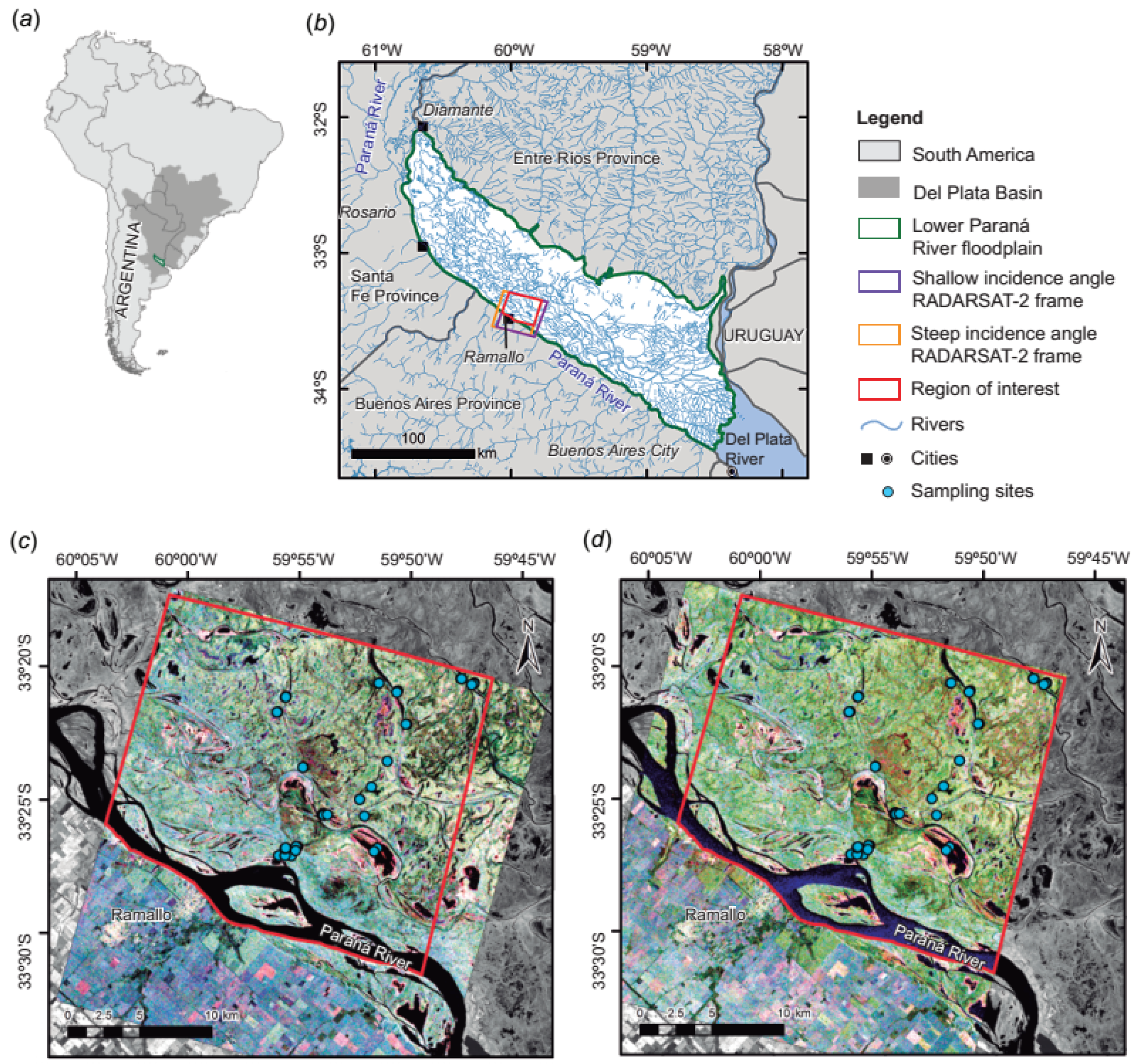
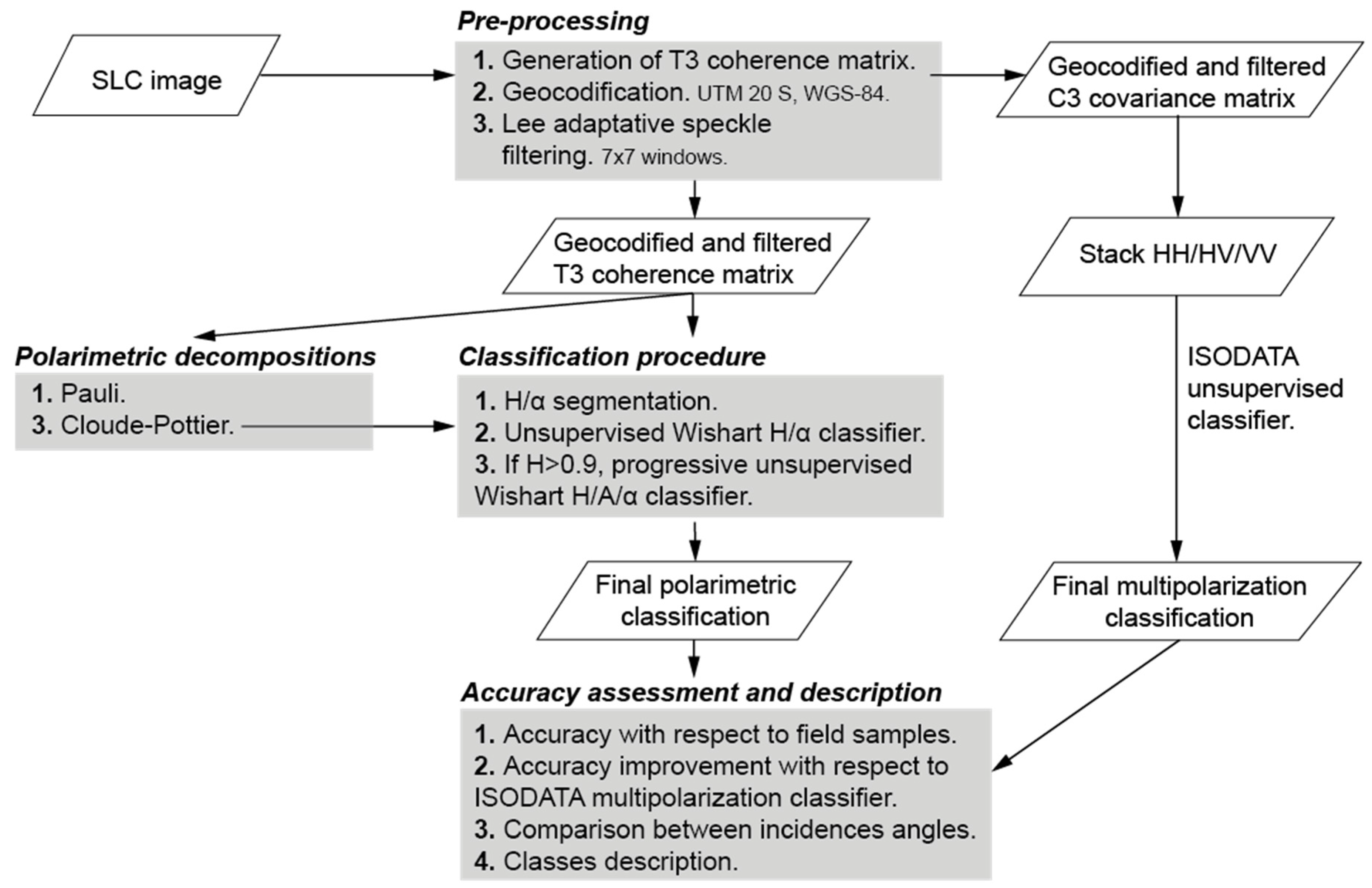

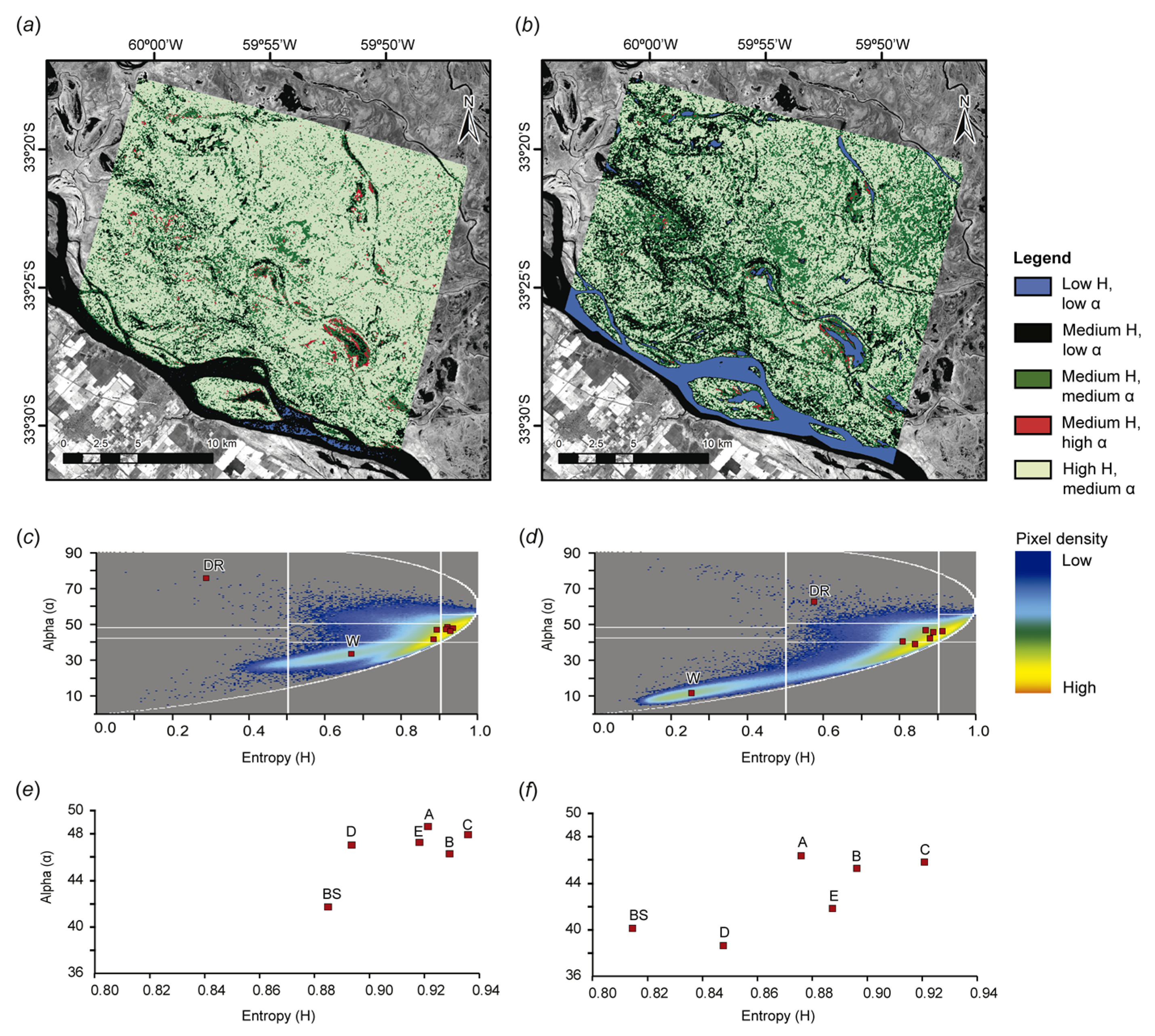
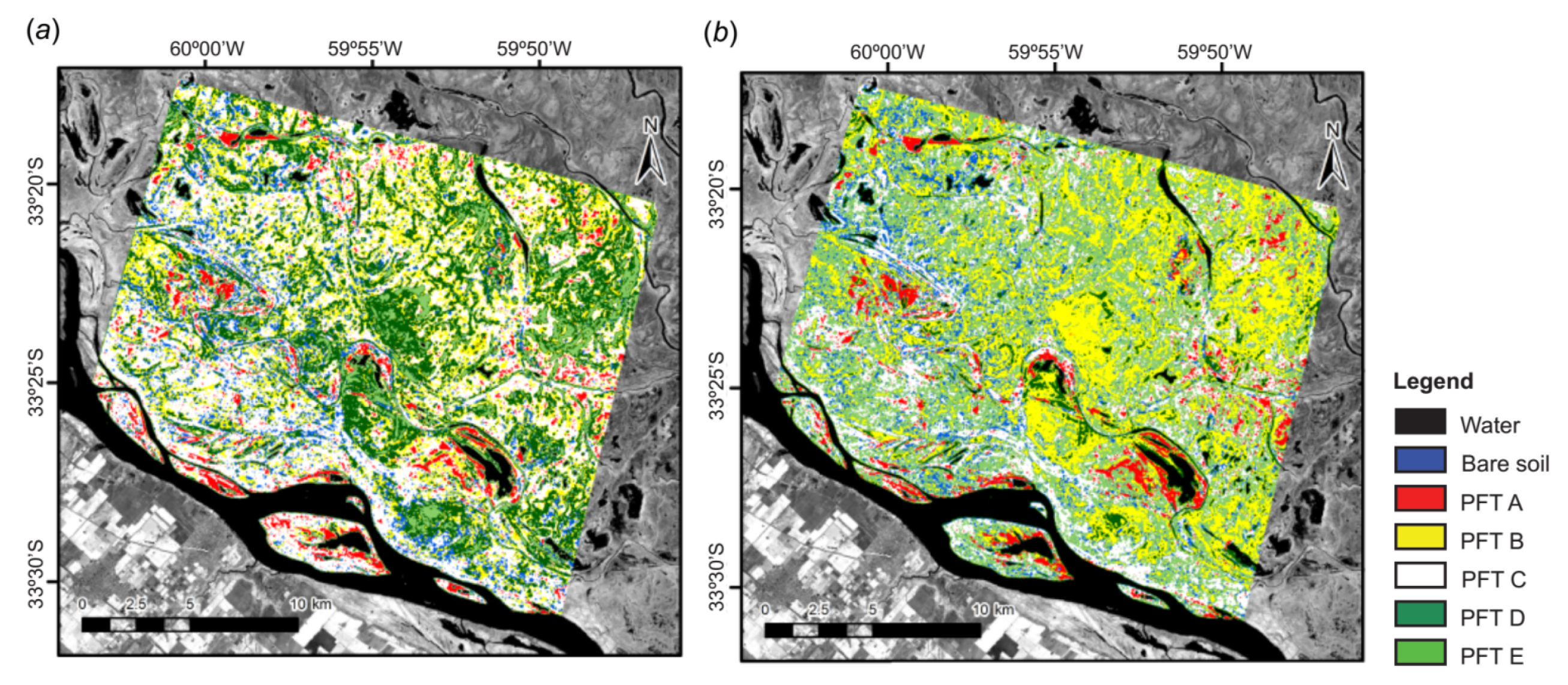
| Scene | Shallow Incidence Angle | Steep Incidence Angle |
|---|---|---|
| Date | 30 January 2011 | 2 February 2011 |
| Beam Mode | Fine Quad-Pol | Fine Quad-Pol |
| Polarization Options | HH, VV, HV, VH | HH, VV, HV, VH |
| Product | SLC | SLC |
| Beam | FQ24 | FQ08 |
| Near incidence angle | 42.8° | 26.9° |
| Far incidence angle | 44.1° | 28.7° |
| Near resolution | 7.7 m | 11.5 m |
| Far resolution | 7.5 m | 10.8 m |
| Nominal pixel spacing | 4.7 m × 5.1 m | 4.7 m × 5.1 m |
| Resolution | 5.2 m × 7.6 m | 5.2 m × 7.6 m |
| Nominal scene size | 25 km × 25 km | 25 km × 25 km |
| Number of looks | 1 × 1 | 1 × 1 |
| PFT | A | B | C | D | E | |
|---|---|---|---|---|---|---|
| Morphoecological type | Equisetoid herbs | Broadleaf herbs | Graminoid herbs | |||
| Physiognomy | Bulrush marshes | Short broadleaf marshes | Tall broadleaf marshes | Short grasslands and grass marshes | Tall grasslands and grass marshes | |
| Plant height | 140–250 cm | <150 cm (most: <80 cm) | 150–250 cm. | <50 cm | 50–150 cm | |
| Aboveground green biomass | 290–2330 g·m−2 | 250–1320 g·m−2 | 370–1390 g·m−2 | 110–620 g·m−2 | 100–3340 g·m−2 | |
| Aboveground green biomass distribution | Biomass distributed in vertically oriented cylindrical stems. | Biomass distributed in broadleaf leaves. Generally, few leaves with large leaf areas. Weak stems, often hollow stems or with aerenchyma tissues. Both decumbent and erect plants. Biomass amount does not depend on plant height. | Biomass distributed in broadleaf leaves and stems. Generally, abundant leaves with small leaf areas. Stronger stems than in PFT B, often not hollow. Erect plants. Biomass amount increases with plant height. | Biomass distributed in leaf blades. Generally, not hollow stems. Generally, decumbent plants. | Biomass distributed in leaf blades and leaf sheaths. Either hollow or not hollow stems. Generally, erect plants. | |
| Functional features | Strong competitors growing in low topographic positions, in generally flooded sites. Clonal and perennial. Rapid regeneration. Tall plants with large seed size, low specific photosynthetic area, low leaf N. C3 plants. | Ruderal plants growing in low topographic positions, in generally flooded or soil-saturated sites with high soil fertility (usually high N). Clonal and perennial. Medium specific leaf area, medium to high leaf nitrogen. C3 plants. | Intermediate ruderal-competitor plants, growing in high (non-flooded sites; e.g., Baccharis salicifolia, Conyza bonariensis) or in low topographic positions (flooded sites; e.g., Ludwigia cf. peruviana). Annual and clonal plants. Medium specific leaf area, medium to high leaf N. C3 plants. | Stress-tolerant species (both for salinity or dry conditions) or ruderal species, growing in high or medium topographic positions. Small leaf thickness, low leaf N and chlorophyll content. Mostly C4 plants | Ruderal plants (or tolerant to salinity stress, Leptochloa fusca), growing in low or medium topographic positions. Either annual plants or clonal perennial plants. Both C3 and C4 plants. | |
| Species | Schoenoplectus californicus, Cyperus giganteus. | Sagittaria montevidensis, Eclipta prostrata, Enydra anagallis, Oplismenopsis najada, Polygonum acuminatum, Ludwigia cf. peruviana. | Baccharis salicifolia, Conyza bonariensis, Polygonum acuminatum, Ludwigia cf. peruviana. | Cynodon dactylon, Paspalum vaginatum, Echinochloa helodes, Echinochloa polystachya var. spectabilis. | Panicum elephantipes, Hymenachne pernambucense, Echinochloa crus-gallis, Bolboschoenus robustus, Leptochloa fusca. | |
| No.sites dominated | 8 | 9 | 4 | 8 | 10 | |
| Predicted contribution of the scattering mechanisms | Volume | Medium | Medium | High | Low | Medium-High |
| Surface | Low-Null | Low-Null | Low-Null | Medium-High | Low-Null | |
| Double-bounce | Medium-High | Low-Null | Low | Low-Null | Low | |
| Scene | Shallow Incidence Angle | Steep Incidence Angle | ||||
|---|---|---|---|---|---|---|
| Class labeling | A priori criteria and Maximizing Kappa | A priori criteria | Maximizing Kappa | |||
| Open-water class | Included | Not included | Included | Not included | Included | Not included |
| Overall accuracy (%) | 61.5 | 52.4 | 46.2 | 35 | 53.3 | 42.9 |
| Kappa index (%) | 54.8 | 42.5 | 29.4 | 9.7 | 45.1 | 29.6 |
| Kappa 95% confidence interval (%) | 39.2–70.3 | 24.2–60.7 | 13.6–45.1 | 0.0–26.0 | 28.9–61.2 | 11.1–48.0 |
| Improvement with regard to multipolarization Isodata classification (%) | 20.7 | 34.2 | 8.2 | 16.9 | 24.8 | 7.5 |
© 2016 by the authors; licensee MDPI, Basel, Switzerland. This article is an open access article distributed under the terms and conditions of the Creative Commons by Attribution (CC-BY) license (http://creativecommons.org/licenses/by/4.0/).
Share and Cite
Morandeira, N.S.; Grings, F.; Facchinetti, C.; Kandus, P. Mapping Plant Functional Types in Floodplain Wetlands: An Analysis of C-Band Polarimetric SAR Data from RADARSAT-2. Remote Sens. 2016, 8, 174. https://doi.org/10.3390/rs8030174
Morandeira NS, Grings F, Facchinetti C, Kandus P. Mapping Plant Functional Types in Floodplain Wetlands: An Analysis of C-Band Polarimetric SAR Data from RADARSAT-2. Remote Sensing. 2016; 8(3):174. https://doi.org/10.3390/rs8030174
Chicago/Turabian StyleMorandeira, Natalia S., Francisco Grings, Claudia Facchinetti, and Patricia Kandus. 2016. "Mapping Plant Functional Types in Floodplain Wetlands: An Analysis of C-Band Polarimetric SAR Data from RADARSAT-2" Remote Sensing 8, no. 3: 174. https://doi.org/10.3390/rs8030174





